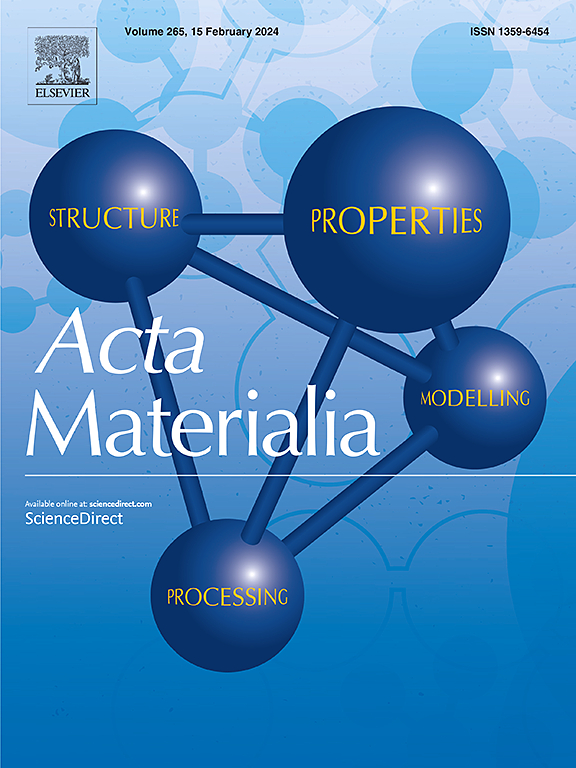晶格缺陷对HPT处理的p型角方石DD0.7Fe3CoSb12的结构、力学和物理性能的影响
IF 8.3
1区 材料科学
Q1 MATERIALS SCIENCE, MULTIDISCIPLINARY
引用次数: 0
摘要
本文系统地研究了高压扭转处理的p型方钨矿DD0.7Fe3CoSb12样品,以阐明其力学性能增强的机制,特别是热电性能ZT的增强机制。我们首次将实验(差示扫描量热法、x射线衍射法、能量色散光谱法和扫描电子显微镜法)与密度泛函理论(DFT)计算相结合。结果表明,hpt加工中晶格缺陷的个别热稳定性,特别是它们的密度和阵列,是观察到的性质的原因。力学性能主要受位错和晶界的影响,而热电性能ZT受空位型缺陷的产生和湮灭的影响:这些允许在HPT诱导的位错中形成低角度晶界,随着变形和退火温度的增加,晶粒之间的错取向增加。与简单纠缠的位错细胞壁相比,这些低/高角度晶界对电阻率和导热系数的影响最小,因此对ZT的影响最大。DFT计算不仅提供了NdFe4Sb12和NdCo4Sb12中三个原子位的空位形成能,而且还揭示了这些化合物的稳定性。NdCo4Sb12中的Nd空位形成是能量消耗最少的,这使得结构比NdFe4Sb12中的Nd空位形成更稳定,在NdFe4Sb12中,电子赤字的减少与结构畸变的增加相竞争。本文章由计算机程序翻译,如有差异,请以英文原文为准。


The role of lattice defects for structural, mechanical, and physical properties of HPT processed p-type skutterudite DD0.7Fe3CoSb12
HPT (high pressure torsion)-processed samples of p-type skutterudite DD0.7Fe3CoSb12 were systematically investigated for clarifying the mechanisms behind the enhancements of mechanical properties and particularly of the thermoelectric figure of merit ZT. For the first time we combined experiments (differential scanning calorimetry, X-ray diffractometry, energy dispersive spectroscopy, and scanning electron microscopy) with calculations by density functional theory (DFT). The results demonstrated that the individual thermal stabilities of lattice defects from HPT-processing with special respect to their densities and arrays are responsible for the properties observed. The mechanical properties are mainly governed by dislocations and grain boundaries, while the thermoelectric figure of merit ZT is affected by the generation and annihilation of vacancy type defects: These allow for the formation of low-angle grain boundaries out of the HPT induced dislocations with increasing misorientation between the grains as a function of deformation and annealing temperature. In contrast to simply entangled dislocation cell walls, these low/high angle grain boundaries account for a minimum of the product of resistivity and thermal conductivity, and thus of a maximum of ZT. DFT calculations not only provided formation energies of vacancies for the three atom sites in NdFe4Sb12 and NdCo4Sb12, but also insight on the stabilities of these compounds. The Nd vacancy formation in NdCo4Sb12 is the least energy-demanding, which makes the structure more stable than e.g. the Nd vacancy formation in NdFe4Sb12, where decreasing electron deficit competes with increasing structure distortion.
求助全文
通过发布文献求助,成功后即可免费获取论文全文。
去求助
来源期刊

Acta Materialia
工程技术-材料科学:综合
CiteScore
16.10
自引率
8.50%
发文量
801
审稿时长
53 days
期刊介绍:
Acta Materialia serves as a platform for publishing full-length, original papers and commissioned overviews that contribute to a profound understanding of the correlation between the processing, structure, and properties of inorganic materials. The journal seeks papers with high impact potential or those that significantly propel the field forward. The scope includes the atomic and molecular arrangements, chemical and electronic structures, and microstructure of materials, focusing on their mechanical or functional behavior across all length scales, including nanostructures.
 求助内容:
求助内容: 应助结果提醒方式:
应助结果提醒方式:


